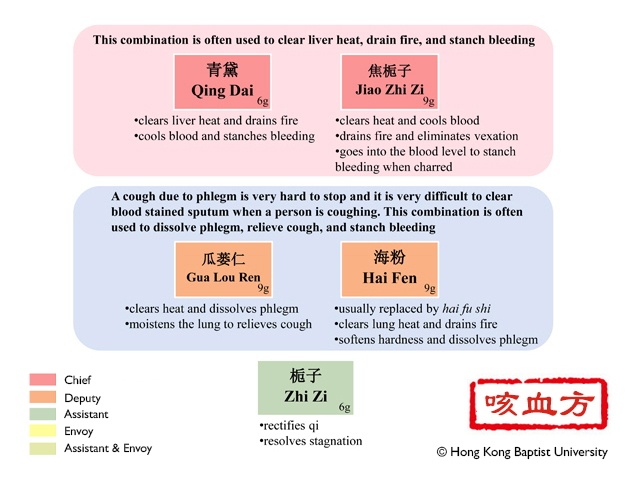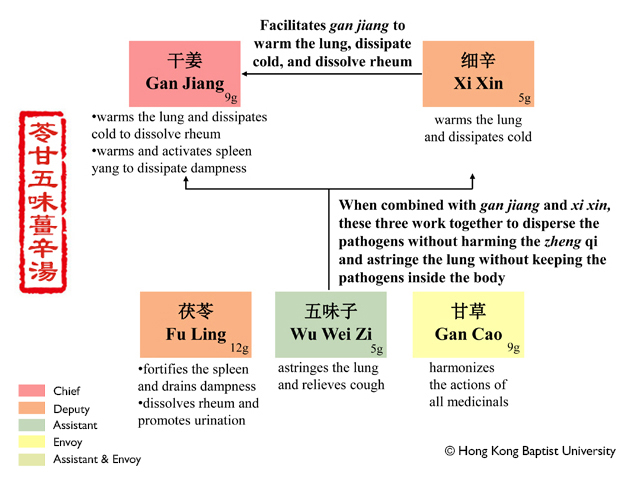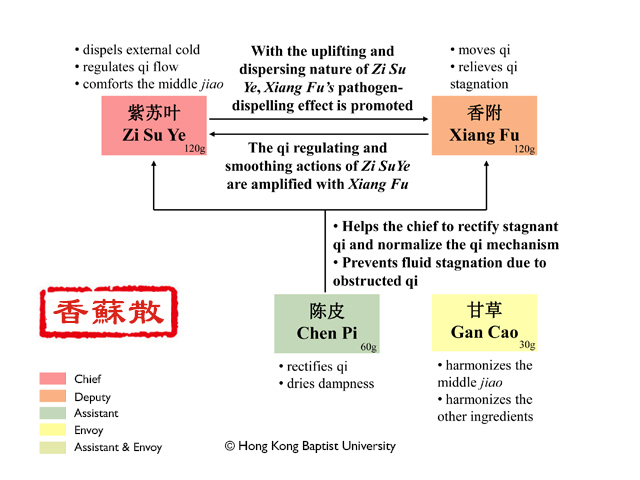| Numbering |
|
Name |
|
Combination |
|
Action |
|
Indication |
|
Thumbnail |
|
89
|
|
Coughing with Blood Treating Decoction
|
|
Indigo Naturalis; Trichosanthis Fructus; Dried Sea Hare Ovary; Gardeniae Fructu; Chebulae Fructus
|
|
Clears liver heat and calms the lung, cools blood and stanches bleeding.
|
|
Syndrome of hemoptysis due to liver fire invading the lung marked by cough, thick bloodstained sputum, difficulty in spitting, vexation, irascibility, chest pain, dry throat, bitter taste in the mouth, flushed complexion, and constipation. The tongue body is red and the coating is yellow, and the pulse is wiry and rapid.
|
|

|
|
90
|
|
Poria, Licorice Root, Schisandra, Dried Ginger, and Asarum Decoction
|
|
Poria; Glycyrrhizae Radix et Rhizoma; Zingiberis Rhizoma; Asari Radix et Rhizoma; Schisandrae Chinensis Fructus
|
|
Warms the lung and dissolves rheum.
|
|
Ling Gan Wu Wei Jiang Xin Tang is indicated for coughing caused by a pattern of cold fluid-retention marked by coughing with a large amount of thin white sputum, a preference to spit out saliva, drooling, and a stuffy chest. The tongue coating is white and glossy and the pulse is wiry and slippery.
|
|

|
|
91
|
|
Poria, Cinnamon Twig, Atractylodes Macrocephala and Licorice Decoction
|
|
Poria; Cinnamomi Ramulus; Atractylodis Macrocephalae Rhizoma; Glycyrrhizae Radix et Rhizoma Praeparata cum Melle
|
|
Warms yang and dissolves rheum, fortifies the spleen and drains dampness.
|
|
Ling Gui Zhu Gan Tang is indicated for phlegm-rheum due to deficiency of the middle-yang. The symptoms are distention and fullness of chest and rib-side, dizzy vision, palpitations, shortness of breath, and cough. The tongue coating is white and glossy. The pulse is either wiry and slippery or deep and tight.
|
|

|
|
92
|
|
Cyperus and Perilla Powder
|
|
Cyperi Rhizoma; Perillae Folium; Glycyrrhizae Radix et Rhizoma; Citri Reticulatae Pericarpium
|
|
Scatters and dissipates external wind wind-cold, rectifies qi and harmonizes the middle jiao.
|
|
Xiang Su San is indicated for an externally contracted wind-cold with qi constraint pattern. Signs and symptoms are aversion to cold, general fever, headache, absence of sweating, chest and epigastric fullness and distress, lack of appetite, a thin and white tongue coating and a superficial pulse.
|
|

|

